组织行为学译文
- 格式:doc
- 大小:102.50 KB
- 文档页数:17
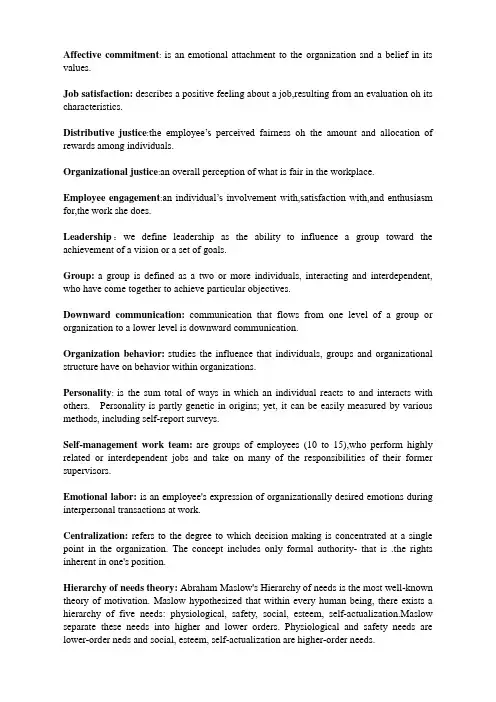
Affective commitment: is an emotional attachment to the organization snd a belief in its values.Job satisfaction:describes a positive feeling about a job,resulting from an evaluation oh its characteristics.Distributive justice:the employee’s perceived fairness oh the amount and allocation of rewards among individuals.Organizational justice:an overall perception of what is fair in the workplace.Employee engagement:an individual’s involvement with,satisfaction with,and enthusiasm for,the work she does.Leadership:we define leadership as the ability to influence a group toward the achievement of a vision or a set of goals.Group:a group is defined as a two or more individuals, interacting and interdependent, who have come together to achieve particular objectives.Downward communication:communication that flows from one level of a group or organization to a lower level is downward communication.Organization behavior:studies the influence that individuals, groups and organizational structure have on behavior within organizations.Personality: is the sum total of ways in which an individual reacts to and interacts with others. Personality is partly genetic in origins; yet, it can be easily measured by various methods, including self-report surveys.Self-management work team:are groups of employees (10 to 15),who perform highly related or interdependent jobs and take on many of the responsibilities of their former supervisors.Emotional labor: is an employee's expression of organizationally desired emotions during interpersonal transactions at work.Centralization: refers to the degree to which decision making is concentrated at a single point in the organization. The concept includes only formal authority- that is .the rights inherent in one's position.Hierarchy of needs theory: Abraham Maslow's Hierarchy of needs is the most well-known theory of motivation. Maslow hypothesized that within every human being, there exists a hierarchy of five needs: physiological, safety, social, esteem, self-actualization.Maslow separate these needs into higher and lower orders. Physiological and safety needs are lower-order neds and social, esteem, self-actualization are higher-order needs.Perception:is a process by which individuals organize and interpret their sensory impressions in order to give meaning to their environment.Motivation:is the processes that account for an individual's intensity,direction, and persistence of effort toward attaining a goal.Organizational structure:an Organizational structure defines how job tasks are formally divided, grouped, and coordinated. There are six key elements that managers need to address when designing their Organization's structure: work specialization, departmentalization, chain of command, span of control, centralization and decentralization, and formalization.Communication process:(P144 exhibit 10-1 ) includes the sender, encoding,the message, the channel, decoding, the receiver, noise, and feedback.Job characteristics model:proposes that any job can be described in terms of five core job dimensions: skill variety, task identity, task significance, autonomy, and feedback.(P 81-82)Formolization: refers to the degree to which jobs within the organization are standardized.Filtering:refers to a sender's purposely manipulating information so it will be seen more favorably by the receiver.Self-efficacy: refers to an individual's belief that he or she is capable of performing a task.Attitude: attitudes are evaluation statements-either favorable or unfavorable-about objects, people,or events. They reflect how we feel about something.Power:refers to a capacity that A has to influence the behavior of B so that B acts in accordance with A's withes.(P181)A Work team:generates positive synergy through coordinated effort. The individuals effort result in a level of performance that is greater than the sum of those individual inputs.Communication:includes both the transfer and the understanding of meaning among individuals, a group or an organization.Big five model: Five basic dimensions underlie all others and encompass most of significant variation in human personality. The big five factors are extraversion, agreeableness, conscientiousness, emotional stability, openness to experience.感觉有不对的尽快跟小哈丹说一下~大家慢慢背,话说是11号考试~。
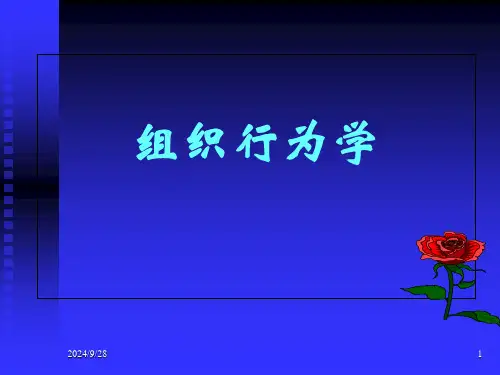
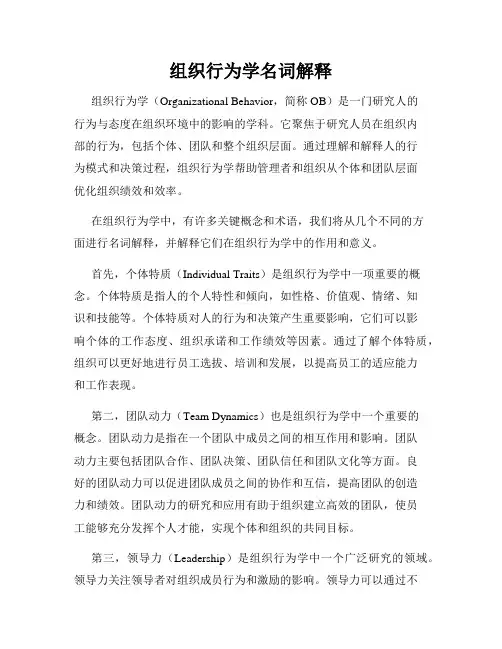
组织行为学名词解释组织行为学(Organizational Behavior,简称OB)是一门研究人的行为与态度在组织环境中的影响的学科。
它聚焦于研究人员在组织内部的行为,包括个体、团队和整个组织层面。
通过理解和解释人的行为模式和决策过程,组织行为学帮助管理者和组织从个体和团队层面优化组织绩效和效率。
在组织行为学中,有许多关键概念和术语,我们将从几个不同的方面进行名词解释,并解释它们在组织行为学中的作用和意义。
首先,个体特质(Individual Traits)是组织行为学中一项重要的概念。
个体特质是指人的个人特性和倾向,如性格、价值观、情绪、知识和技能等。
个体特质对人的行为和决策产生重要影响,它们可以影响个体的工作态度、组织承诺和工作绩效等因素。
通过了解个体特质,组织可以更好地进行员工选拔、培训和发展,以提高员工的适应能力和工作表现。
第二,团队动力(Team Dynamics)也是组织行为学中一个重要的概念。
团队动力是指在一个团队中成员之间的相互作用和影响。
团队动力主要包括团队合作、团队决策、团队信任和团队文化等方面。
良好的团队动力可以促进团队成员之间的协作和互信,提高团队的创造力和绩效。
团队动力的研究和应用有助于组织建立高效的团队,使员工能够充分发挥个人才能,实现个体和组织的共同目标。
第三,领导力(Leadership)是组织行为学中一个广泛研究的领域。
领导力关注领导者对组织成员行为和激励的影响。
领导力可以通过不同的风格和方法发挥作用,在组织内部对员工进行指导、激励和管理。
不同领导风格的运用可以影响员工的工作动机、满意度和绩效。
研究和实践领导力有助于组织培养和发展有效的领导者,并提高组织的领导力水平。
第四,组织文化(Organizational Culture)也是组织行为学中的重要概念。
组织文化是指在一个组织中共享的价值观、信念、规范和行为方式。
组织文化可以影响员工的态度、行为和工作方式,因此对于组织绩效和员工满意度具有重大影响。
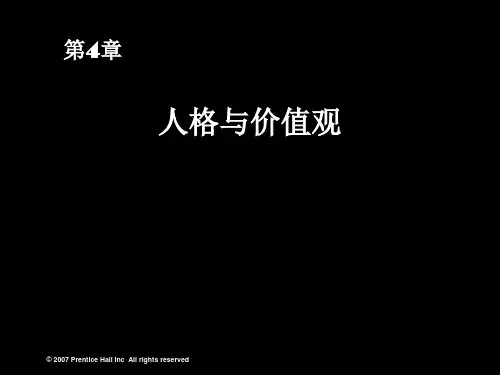
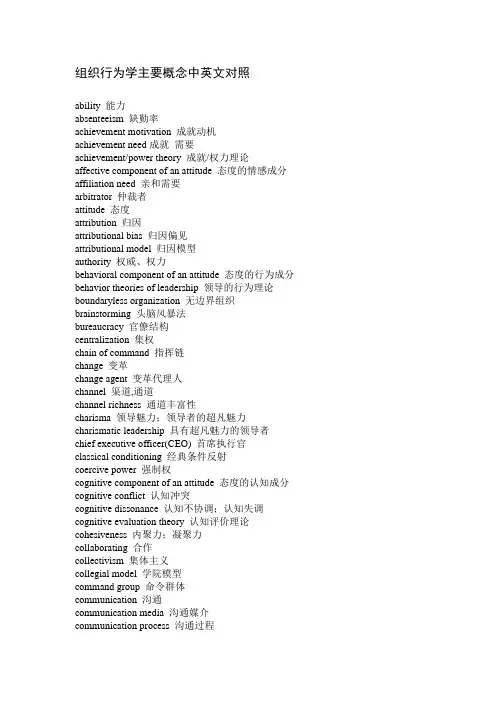
组织行为学主要概念中英文对照ability 能力absenteeism 缺勤率achievement motivation 成就动机achievement need成就需要achievement/power theory 成就/权力理论affective component of an attitude 态度的情感成分affiliation need 亲和需要arbitrator 仲裁者attitude 态度attribution 归因attributional bias 归因偏见attributional model 归因模型authority 权威、权力behavioral component of an attitude 态度的行为成分behavior theories of leadership 领导的行为理论boundaryless organization 无边界组织brainstorming 头脑风暴法bureaucracy 官僚结构centralization 集权chain of command 指挥链change 变革change agent 变革代理人channel 渠道,通道channel richness 通道丰富性charisma 领导魅力;领导者的超凡魅力charismatic leadership 具有超凡魅力的领导者chief executive officer(CEO) 首席执行官classical conditioning 经典条件反射coercive power 强制权cognitive component of an attitude 态度的认知成分cognitive conflict 认知冲突cognitive dissonance 认知不协调;认知失调cognitive evaluation theory 认知评价理论cohesiveness 内聚力;凝聚力collaborating 合作collectivism 集体主义collegial model 学院模型command group 命令群体communication 沟通communication media 沟通媒介communication process 沟通过程communication networks 沟通网络compromising 妥协conceptual skills 概念分析技能conciliator 调停者conflict 冲突conflict management 冲突管理conflict process 冲突过程conformity 从众content theories of motivation 内容型激励理论contingency model of leadership 领导的权变模型contrast effects 对比效应core dimensions of jobs 工作的核心纬度core values 核心价值观counseling 咨询cross-cultural communication 跨文化沟通cross-function teams 跨职能团队culture 文化decentralization 分权decisions 决策decoding 译码;解码delegation 授权Delphi technique 德尔菲法departmentalism 部门化dependent variables 因变量distributive bargaining 分配谈判distributive justice 分配公平downward communication 下行沟通dysfunctional conflict 功能失常性冲突employee stock ownership plans(ESOPs)员工持股计划encoding 编码environment 环境equity theory 公平理论ERG theory ERG理论esteem needs 尊重需要existence needs 生存需要expectancy 期望expectancy theory 期望理论expert power 专家权力face-to-face communication 面对面的沟通Fiedler contingency model 费德勒权变模型formal group 正式群体formalization 正规化formalization stage 正规化阶段forming 形成functional conflict 功能正常性冲突fundamental attribution error 基本归因错误Gain sharing plan 收益分享计划goal setting 目标设置goal-setting theory 目标设置理论group 群体groupthink 群体思维growth need 成长需要halo effect 晕轮效应Hawthorne experiment 霍桑效应hierarchy of needs theory 需要层次理论higher-order needs 高层次需要horizontal conflict 横向冲突human relations 人际关系human skills 人际技能hygiene factors 保健因素illegitimate political behavior 非法的政治行为incentives 刺激;诱因independent variables 自变量individual differences 个体差异individualism 个人主义informal group 非正式群体informal leaders 非正式领导informal network 非正式网络informal organization 非正式组织information-based power 信息权information technology 信息技术instrumental values 工具性价值观integrative bargaining 整合谈判intergroup conflict 群体间冲突internal locus of control 内部控制点internals 内控者interorganizational conflict 组织间冲突interpersonal conflict 人际冲突intragroup conflict 群体内冲突intraorganizational conflict 组织内冲突intrapersonal conflict 个人内部冲突intuitive decision making 直觉决策lateral communication 横向沟通Leader-Member exchange(LMX) theory 领导-员工交换理论leader-participation model 领导参与模型leadership 领导leadership style 领导方式leading 领导learning 学习learning organization 学习型组织learning theory 学习理论Least-Preferred Co-worker(LPC) questionnaire 最难共事者问卷legitimate political behavior 合法的政治行为legitimate power 合法权利locus of control 控制点lower-order needs 低层次需要Maslow`s theory of needs 马斯洛需求理论Machiavellianism 马基雅维里主义maintenance factor 保健因素Management By Objectives(MBO) 目标管理Management By Walking Around(MBWA) 走动式管理managerial grid 管理方格图managers 管理者;经理matrix organization 矩阵组织matrix structure 矩阵结构Meclelland`s theory of needs 麦克利兰的需求理论mechanistic organizations 机械组织meditation 调停mediator 调停者models of organizational behavior 组织行为模型Motivating Potential Score(MPS) 激励的潜在分数Motivation 激励;动机motivation-hygiene theory 激励-保健理论motivational factors 激励因素motivational patterns 激励类型Need 需要needs theories 需要理论negative reinforcement 负强化neglect 忽略;疏忽negotiation 谈判;协商network 网络nominal group 名义群体Nominal Group Technique(NGT) 名义群体法nonverbal communication 非言语沟通norm 常规;规范;定额;平均数norming 规范化operant conditioning 操作性条件反射organic organizations 有机组织organization 组织Organizational Behavior(OB) 组织行为organizational culture 组织文化organizational citizens 组织公民organizational design 组织设计organizational development 组织发展organizational politics 组织政治organizational socialization 组织社会化organizational structure 组织结构organizational life cycle 组织生命周期organizing 组织Participation 参与participative counseling 参与式咨询participative leader 参与式领导者participative management 参与式管理path-goal theory 途径-目标理论perception 知觉perceptual biases 知觉偏见perceptual error 知觉错误performance-outcome expectancies 绩效-产出期望performance-satisfaction-effort loop 绩效-满意-努力环personal-based influence 个人影响力personal power 个人权力personality 个性;人格personality-job fit theory 个性-工作匹配理论personality traits 人格特质piece rate 计件工资piece-rate pay plans 计件工资计划piecework system 计件工作系统planned change 有计划的变革polarization 极化political behavior 政治行为political power 政治权利politics 政治positive reinforcement 正强化position power 职位权力power 权力power distance 权力距离power need 权力需要power tactics 权力战术,权术prejudice 偏见;成见problem-solving teams 问题解决小组procedural justice 程序公正性procedure 程序process consultation 过程咨询production-oriented leader 以生产导向的领导productivity 生产力profit-sharing plan 利润分享计划projection 投射psychological success 心理成功psychological costs 心理成本psychological contract 心理契约psychological distance 心理距离punishment power 惩罚性权力quality circles 质量圈qualify of life 生活质量Qualify of Work Life(QWL) 工作生活质量quantity of life 生活数量rationality 理性realistic job previews 实际工作预览reference group 参照群体reciprocal interdependence 互惠的相互依赖reengineering 工程再造refreezing 重新冻结referent power 参照性权力reinforcement 强化reinforcement theory 强化理论reinforcement schedule 强化程序relatedness need 相互关系需要reliability 信度resistance to change 变革阻力reward power 奖励权role 角色selective perception 选择性知觉self-actualization 自我实现self-efficacy 自我效能self-esteem 自尊self-managing teams 自我管理小组self-serving bias 自我服务偏见sensitivity training 敏感性训练shared value 共同价值观situational leadership theory 领导的情境理论skill-based pay 技能工资skill variety 技能多样化social comparison theory 社会比较论social-learning theory 社会学习理论Social Readjustment Rating Scale 社会再适应评估量表Socialization 社会化span of control 控制幅度specification 专业化stereotyping 刻板印象storming 风暴阶段stress 压力stressors 施压源substitutes for leadership 领导的替代物survey feedback 调查反馈synergy 协同作用task significance 任务重要性task structure 任务结构task team 任务小组;任务团队task uncertainty 任务不确定性team building 团队建设technical skills 技术技能technology 技术total quality management(TQM) 全面质量管理traits theories of leadership 领导特质理论transactional leaders 交易型领导turnover 离职率two-factor model of motivation 双因素激励理论type A personality A型人格type B personality B型人格uncertain avoidance 不确定性规避unity of command 统一指挥upward feedback 上行反馈upward communication 上行沟通valence 效价validity 效度value system 价值观体系values 价值观variable-pay programs 可变报酬计划vertical conflict 纵向冲突work force diversity 劳动力多元化work group 工作群体work specialization 工作专业化written communication 书面沟通。
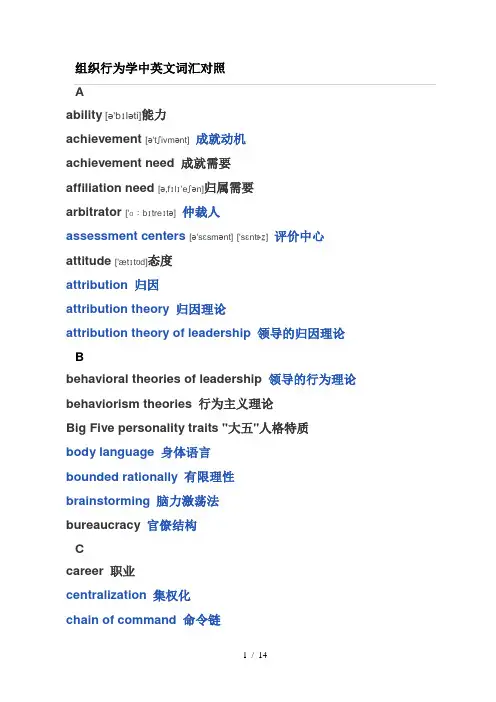
组织行为学中英文词汇对照Aability[ə'bɪləti]能力achievement [ə'tʃivmənt]成就动机achievement need 成就需要affiliation need [ə,fɪlɪ'eʃən]归属需要arbitrator ['ɑːbɪtreɪtə]仲裁人assessment centers[ə'sɛsmənt]['sɛntɚz]评价中心attitude ['ætɪtʊd]态度attribution归因attribution theory归因理论attribution theory of leadership领导的归因理论Bbehavioral theories of leadership 领导的行为理论behaviorism theories 行为主义理论Big Five personality traits "大五"人格特质body language身体语言bounded rationally有限理性brainstorming脑力激荡法bureaucracy 官僚结构Ccareer 职业centralization集权化chain of command命令链charismatic leadership 领袖魅力的领导charismatic leadership theories魅力领导理论classical conditioning 经典条件反射cliques 小集团cognitive component of an attitude 态度的认知成分cognitive learning 认知学习cognitive theories 认知理论cohesiveness凝聚力collaborating协作command group命令型群体communication沟通communication apprehension沟通焦虑communication networks 沟通网络communication process沟通过程competence 能力competing 竞争compromising 折中conciliator 和解人conflict冲突conflict management冲突管理conflict process 冲突过程conformity 从众问题conscientiousness 责任心consideration 关怀维度consistency 一贯contingency approaches to management 管理的权变途径contingency leadership theory领导权变理论continuous reinforcement 连续强化contrast effects对比效应control theory控制理论controlling 控制core values核心价值观creativity创造力cross-functional teams多功能型团队cultural differences 文化差异Ddecision making决策decision rationality 决策理性decision role决策角色decision-making style 决策风格decisions 决策decoding 解码delegating style 授权风格Delphi technique 德尔菲技术Departmentalization部门化dispositional attributions 个性归因distributive bargaining分配谈判distributive justice 分配公平diversity 多元化dominant culture 主导文化downward communication下行沟通Dynamics of Synergy 协力优势dysfunctional conflict 功能失调的冲突Eeconomic rationality model 经济理性模型emotion 情绪emotional intelligence情绪智力emotional stability 情绪稳定性mployee involvement 员工参与employee-oriented leader 员工导向的领导者empowerment授权encoding 编码encounter stage 碰撞阶段engagement 卷入environment 环境equity theory公平理论equity theory of work motivation 工作动机的公平理论ERG theory ERG理论exchange leadership theories 领导的交换理论expectancy theory期望理论export power专家性权力external validity 外部效度externals 外控者extraversion 外向性extrinsic motive 外源性动机extrinsic rewards 外部报酬Ffeedback 反馈Fiedler contingency model 费德勒的权变模型filtering 过滤Five-Factor Model(FFM) 五因素模型flexible benefits灵活福利formal group 正式群体formal networks 正式沟通网络formal organization正式组织function conflict 功能正常的冲突functional analysis 功能性分析fundamental attribution error 基本归因偏差Ggeneral mental ability(GMA) 一般心理能力goal conflict目标冲突goal setting 目标设定goal sharing 目标共享goal-setting theory目标设置理论group 群体group decision making群体决策group leadership theories领导的群体理论group stressors群体压力源group shift群体转移groupthink群体思维Hhalo effect晕轮效应Hawthorne effect霍桑效应Herzberg's Two-Factor Theory of Motivation赫茨伯格的动机双因素理论horizontal organization扁平化组织human capital人力资本human relations views of conflict 冲突的人际关系观点hygiene factors 保健因素Iincentives 诱因informal groups非正式群体informal network 非正式沟通网络information richness 信息丰富性initiating structure 结构维度instrumental values 工具价值观integrative bargaining 综合谈判intergroup dynamics 组间动力integrity 正直intellectual ability心理能力intelligence activity 智力活动interacting groups 互动群体interactional view of conflict 冲突的相互作用观点interest group 利益型群体internal validity 内部效度internals 内控者interpersonal communication人际沟通interpersonal roles人际角色intrinsic motive 内源性动机intrinsic rewards 内部报酬intuition 直觉Jjob design工作设计job enlargement工作扩大化job enrichment工作丰富化job involvement 工作参与job rotation工作轮换job satisfaction工作满意度job specification 工作规范Kknowledge management知识管理Lleader role 领导角色leader-member exchange (LMX) theory 领导者—成员交换理论leader-member relations 领导者—成员关系leadership 领导eadership skill 领导技能learned helplessness习得性无助learning 学习learning organization学习型组织least preferred coworker (LPC) questionnaire 最难共事者问卷life-cycle approach生命周期理论lower-order needs 较低层次的需要loyalty 忠诚Mmanagement by objectives (MBO) 目标管理Management Information System(MIS) 管理信息系统managerial communication model 管理沟通模型managerial grid管理方格论managerial grid style 管理方格风格managers管理者Maslow's hierarchy of needs 马斯洛的需要层次理论means-ends chain途径—目标链monitor 监控者mood 心情motivation 激励multicultural organization 多元文化型组织Nneed 需要negative reinforcement负性强化neglect 忽略negotiation谈判negotiation skills 谈判技巧nominal group technique名义群体技术nonverbal communication非语言沟通normative commitment 规范承诺norms 规范Ooperant conditioning 操作条件反射organization 组织organizational behavior (OB) 组织行为学Organizational Citizenship Behaviors(OCBs) 组织的公民行为organizational commitment组织承诺organizational culture组织文化organizational development组织发展Organizational Hierarchies 组织层级organizational structure组织结构Pparticipating style 参与风格participative management参与式管理path-goal leadership theory路径—目标领导理论pay for performance绩效奖金perception 知觉perceptual context 知觉背景personality 人格personality traits 人格特质Porter Lawler motivation model波特—劳勒动机模型position power职位权力positive reinforcement正性强化power权力power motive权力动机power need 权力需要problem-solving teams问题解决型团队production-oriented leader 生产导向的领导者productivity 生产率profit sharing 利润共享projection投射psychological contract心理契约Qquality of life 生活质量quality of work life(QWL) 工作生活质量Rrationality 理性recognition 认可reengineering再造工程reinforcement theory强化理论reinforcers 强化物risky shift phenomenon 风险偏移现象role 角色role ambiguity角色模糊role conflict角色冲突role expectations角色期待role identity 角色同一性role perception角色知觉Ssecurity motive 安全动机selective perception选择性知觉self-actualization 自我实现self-esteem 自尊self-managed teams自我管理团队selling style 推销风格sensitivity training敏感性训练similarity 相似性Simmon's Bounded Rationality Model西蒙的有限理性模型situational attributions 情景归因situational leadership情境领导理论small groups 小群体social cognition theory 社会认知理论social learning 社会学习social loafing社会惰化social perception社会知觉social recognition 社会认可socialization process 社会化过程social-learning theory社会学习理论status 地位status motive 地位动机stereotyping刻板印象storming 震荡stress 压力strong culture 强文化subculture亚文化synergy 协同效应Ttask group任务型群体task structure 任务结构team团队team building团队建设team structure 团队结构terminal values 终极价值观Thematic Apperception Test(TAT) 主题统觉测验theory X X理论theory Y Y理论traditional view of conflict冲突的传统观点trait theories of leadership领导的特质理论transactional leadership交易型领导者transformational leadership变革型领导者trust 信任turnover 流动type A personality A型人格Uupward communication上行沟通Vvalues 价值观virtual organization虚拟组织virtual teams虚拟团队Wwork group工作群体work specialization工作专门化专业词汇(葡语)1. desejos 愿望2. valores opostos,相反的价值观3. Diferentes sistemas de valores不同的价值体系4. negativamente afetado 负面影响5. tem que ser percebido 被感知6. forma de oposição 反对的形式7. solução ganho-ganho 双赢的方案8. interesses利益。
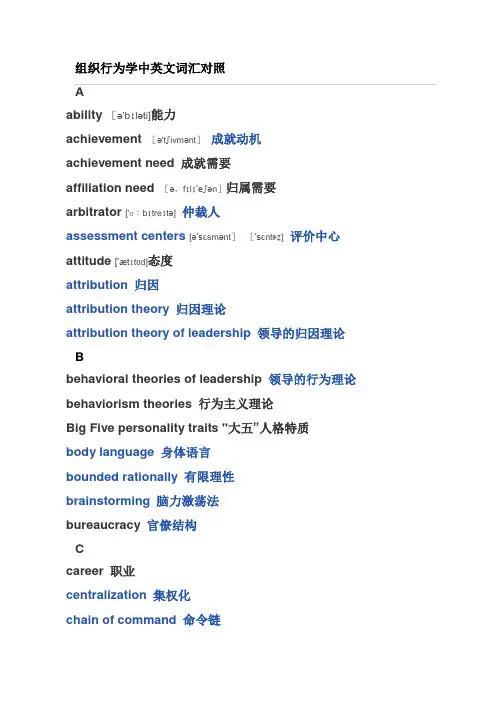
组织行为学中英文词汇对照Aability[ə'bɪləti]能力achievement [ə'tʃivmənt]成就动机achievement need 成就需要affiliation need [ə,fɪlɪ’eʃən]归属需要arbitrator ['ɑːbɪtreɪtə]仲裁人assessment centers[ə’sɛsmənt][’sɛntɚz]评价中心attitude [’ætɪtʊd]态度attribution归因attribution theory归因理论attribution theory of leadership领导的归因理论Bbehavioral theories of leadership 领导的行为理论behaviorism theories 行为主义理论Big Five personality traits "大五”人格特质body language身体语言bounded rationally有限理性brainstorming脑力激荡法bureaucracy 官僚结构Ccareer 职业centralization集权化chain of command命令链charismatic leadership 领袖魅力的领导charismatic leadership theories魅力领导理论classical conditioning 经典条件反射cliques 小集团cognitive component of an attitude 态度的认知成分cognitive learning 认知学习cognitive theories 认知理论cohesiveness凝聚力collaborating协作command group命令型群体communication沟通communication apprehension沟通焦虑communication networks 沟通网络communication process沟通过程competence 能力competing 竞争compromising 折中conciliator 和解人conflict冲突conflict management冲突管理conflict process 冲突过程conformity 从众问题conscientiousness 责任心consideration 关怀维度consistency 一贯contingency approaches to management 管理的权变途径contingency leadership theory领导权变理论continuous reinforcement 连续强化contrast effects对比效应control theory控制理论controlling 控制core values核心价值观creativity创造力cross—functional teams多功能型团队cultural differences 文化差异Ddecision making决策decision rationality 决策理性decision role决策角色decision—making style 决策风格decisions 决策decoding 解码delegating style 授权风格Delphi technique 德尔菲技术Departmentalization部门化dispositional attributions 个性归因distributive bargaining分配谈判distributive justice 分配公平diversity 多元化dominant culture 主导文化downward communication下行沟通Dynamics of Synergy 协力优势dysfunctional conflict 功能失调的冲突Eeconomic rationality model 经济理性模型emotion 情绪emotional intelligence情绪智力emotional stability 情绪稳定性mployee involvement 员工参与employee—oriented leader 员工导向的领导者empowerment授权encoding 编码encounter stage 碰撞阶段engagement 卷入environment 环境equity theory公平理论equity theory of work motivation 工作动机的公平理论ERG theory ERG理论exchange leadership theories 领导的交换理论expectancy theory期望理论export power专家性权力external validity 外部效度externals 外控者extraversion 外向性extrinsic motive 外源性动机extrinsic rewards 外部报酬Ffeedback 反馈Fiedler contingency model 费德勒的权变模型filtering 过滤Five—Factor Model(FFM) 五因素模型flexible benefits灵活福利formal group 正式群体formal networks 正式沟通网络formal organization正式组织function conflict 功能正常的冲突functional analysis 功能性分析fundamental attribution error 基本归因偏差Ggeneral mental ability(GMA)一般心理能力goal conflict目标冲突goal setting 目标设定goal sharing 目标共享goal-setting theory目标设置理论group 群体group decision making群体决策group leadership theories领导的群体理论group stressors群体压力源group shift群体转移groupthink群体思维Hhalo effect晕轮效应Hawthorne effect霍桑效应Herzberg’s Two-Factor Theory of Motivation赫茨伯格的动机双因素理论horizontal organization扁平化组织human capital人力资本human relations views of conflict 冲突的人际关系观点hygiene factors 保健因素Iincentives 诱因informal groups非正式群体informal network 非正式沟通网络information richness 信息丰富性initiating structure 结构维度instrumental values 工具价值观integrative bargaining 综合谈判intergroup dynamics 组间动力integrity 正直intellectual ability心理能力intelligence activity 智力活动interacting groups 互动群体interactional view of conflict 冲突的相互作用观点interest group 利益型群体internal validity 内部效度internals 内控者interpersonal communication人际沟通interpersonal roles人际角色intrinsic motive 内源性动机intrinsic rewards 内部报酬intuition 直觉Jjob design工作设计job enlargement工作扩大化job enrichment工作丰富化job involvement 工作参与job rotation工作轮换job satisfaction工作满意度job specification 工作规范Kknowledge management知识管理Lleader role 领导角色leader—member exchange (LMX) theory 领导者—成员交换理论leader-member relations 领导者—成员关系leadership 领导eadership skill 领导技能learned helplessness习得性无助learning 学习learning organization学习型组织least preferred coworker (LPC) questionnaire 最难共事者问卷life-cycle approach生命周期理论lower-order needs 较低层次的需要loyalty 忠诚Mmanagement by objectives(MBO) 目标管理Management Information System(MIS) 管理信息系统managerial communication model 管理沟通模型managerial grid管理方格论managerial grid style 管理方格风格managers管理者Maslow’s hierarchy of needs 马斯洛的需要层次理论means-ends chain途径—目标链monitor 监控者mood 心情motivation 激励multicultural organization 多元文化型组织Nneed 需要negative reinforcement负性强化neglect 忽略negotiation谈判negotiation skills 谈判技巧nominal group technique名义群体技术nonverbal communication非语言沟通normative commitment 规范承诺norms 规范Ooperant conditioning 操作条件反射organization 组织organizational behavior(OB) 组织行为学Organizational Citizenship Behaviors(OCBs)组织的公民行为organizational commitment组织承诺organizational culture组织文化organizational development组织发展Organizational Hierarchies 组织层级organizational structure组织结构Pparticipating style 参与风格participative management参与式管理path—goal leadership theory路径-目标领导理论pay for performance绩效奖金perception 知觉perceptual context 知觉背景personality 人格personality traits 人格特质Porter Lawler motivation model波特—劳勒动机模型position power职位权力positive reinforcement正性强化power权力power motive权力动机power need 权力需要problem—solving teams问题解决型团队production—oriented leader 生产导向的领导者productivity 生产率profit sharing 利润共享projection投射psychological contract心理契约Qquality of life 生活质量quality of work life(QWL)工作生活质量Rrationality 理性recognition 认可reengineering再造工程reinforcement theory强化理论reinforcers 强化物risky shift phenomenon 风险偏移现象role 角色role ambiguity角色模糊role conflict角色冲突role expectations角色期待role identity 角色同一性role perception角色知觉Ssecurity motive 安全动机selective perception选择性知觉self-actualization 自我实现self—esteem 自尊self—managed teams自我管理团队selling style 推销风格sensitivity training敏感性训练similarity 相似性Simmon’s Bounded Rationality Model西蒙的有限理性模型situational attributions 情景归因situational leadership情境领导理论small groups 小群体social cognition theory 社会认知理论social learning 社会学习social loafing社会惰化social perception社会知觉social recognition 社会认可socialization process 社会化过程social-learning theory社会学习理论status 地位status motive 地位动机stereotyping刻板印象storming 震荡stress 压力strong culture 强文化subculture亚文化synergy 协同效应Ttask group任务型群体task structure 任务结构team团队team building团队建设team structure 团队结构terminal values 终极价值观Thematic Apperception Test(TAT)主题统觉测验theory X X理论theory Y Y理论traditional view of conflict冲突的传统观点trait theories of leadership领导的特质理论transactional leadership交易型领导者transformational leadership变革型领导者trust 信任turnover 流动type A personality A型人格Uupward communication上行沟通Vvalues 价值观virtual organization虚拟组织virtual teams虚拟团队Wwork group工作群体work specialization工作专门化专业词汇(葡语)1. desejos 愿望2. valores opostos,相反的价值观3. Diferentes sistemas de valores不同的价值体系4. negativamente afetado 负面影响5. tem que ser percebido 被感知6. forma de oposição 反对的形式7. solução ganho-ganho 双赢的方案8. interesses利益。
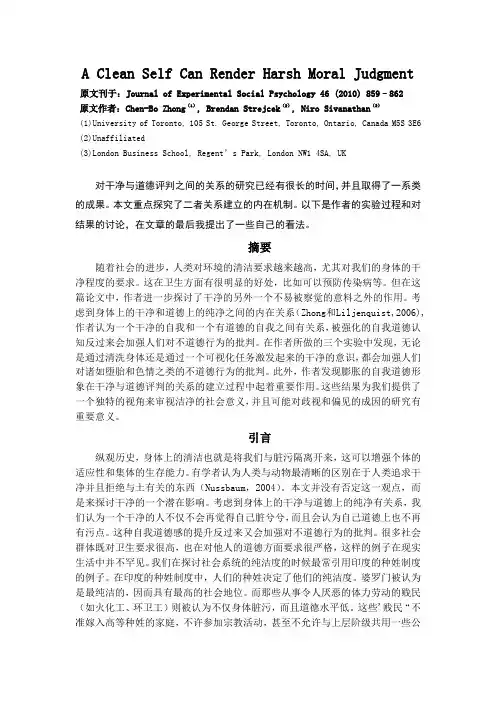
A Clean Self Can Render Harsh Moral Judgment 原文刊于:Journal of Experimental Social Psychology 46 (2010) 859–862原文作者:Chen-Bo Zhong(1), Brendan Strejcek(2), Niro Sivanathan(3)(1)University of Toronto, 105 St. George Street, Toronto, Ontario, Canada M5S 3E6(2)Unaffiliated(3)London Business School, Regent’s Park, London NW1 4SA, UK对干净与道德评判之间的关系的研究已经有很长的时间,并且取得了一系类的成果。
本文重点探究了二者关系建立的内在机制。
以下是作者的实验过程和对结果的讨论,在文章的最后我提出了一些自己的看法。
摘要随着社会的进步,人类对环境的清洁要求越来越高,尤其对我们的身体的干净程度的要求。
这在卫生方面有很明显的好处,比如可以预防传染病等。
但在这篇论文中,作者进一步探讨了干净的另外一个不易被察觉的意料之外的作用。
考虑到身体上的干净和道德上的纯净之间的内在关系(Zhong和Liljenquist,2006),作者认为一个干净的自我和一个有道德的自我之间有关系,被强化的自我道德认知反过来会加强人们对不道德行为的批判。
在作者所做的三个实验中发现,无论是通过清洗身体还是通过一个可视化任务激发起来的干净的意识,都会加强人们对诸如堕胎和色情之类的不道德行为的批判。
此外,作者发现膨胀的自我道德形象在干净与道德评判的关系的建立过程中起着重要作用。
这些结果为我们提供了一个独特的视角来审视洁净的社会意义,并且可能对歧视和偏见的成因的研究有重要意义。
引言纵观历史,身体上的清洁也就是将我们与脏污隔离开来,这可以增强个体的适应性和集体的生存能力。

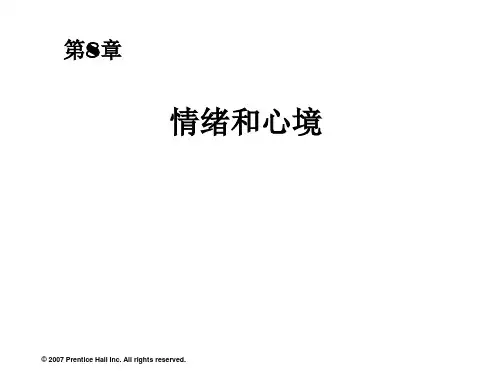

第一章组织行为学概述TAKEAWAYS重点掌握1. 1Organization behavior is a field of study devoted to understanding and explaining the attitudes and groups in organizations. More simply, it focuses on why individuals and groups in organizations act the way they do.1。
1组织行为学的研究领域是一个致力于理解和解释的态度和组织的组合。
通俗地讲,它着重于个人和组织原因群体行为的方式做。
1.2 The two primary outcomes in organizational behavior are job performance and organizational commitment.1.2组织行为中的两个主要成果是工作绩效与组织承诺。
1.3 A number of factors affect performance and commitment, including individual (job satisfaction; stress; motivation; trust, justice, and ethics; learning and decision making), individual characteristics (personality, cultural values, and ability), group mechanisms (teams, leadership), and organizational mechanisms (organizational structure, organizational cultural)1.3许多因素会影响性能,包括个人承诺,(工作满意度;压力;动机,信任,正义,道德,学习和决策),个人特征(个性,文化价值和能力),组机制(队,领导),和组织机制(组织结构,组织文化)。
A型人格:总是不断的驱动自己要在最短的时间里干最多的事情,并在必要的情况下,对阻碍自己的其他人进行攻击。
B不确定性规避:一个国家的人民喜欢结构化而不是非结构化情境的程度。
保健因素:诸如管理质量,薪金水平,公司政策,工作环境这些因素,当这些因素充分时,员工便没有了不满意感。
报酬:泛指雇员做出有偿劳动而获得的回报,包括工资和其他项目,以及非现金的各种员工福利。
C操作性条件发射:一种条件发射类型,认为行为是其结果的函数。
惩罚与忽视:对个人或集体的不良品德行为作出否定的评价或设置了令人不愉快的条件,目的在于控制和促进改正不良品德行为,称为惩罚。
取消维持莫伊行为的所有强化物的方法称为忽视。
长期取向:一种民族文化属性,强调未来,节俭和持久。
创造性:产生新颖而实效想法的能力。
承诺的升级:人们一直固守着某项政策,尽管有明显证据表明该决策是错误的。
成就需要:追求卓越,达到标准,争取成功的内驱力。
从众:个体依据群体规范来调整自己的行为。
D登门坎效应:又称为得寸进尺效应,是指一个一旦接受了他人的一个微不足道的请求,为了避免认知上的不协调,或想给他人前后一致的现象,就更有可能接受更大的需求,这种现象犹如登门坎时一级一级的往上,这样就更容易登上高处。
短期取向:一种民族文化属性,强调过去和现在。
对比效应:对一个人的评价并不是孤立进行的,他常常受到最近接触的其他人的影响。
代表性偏见:不恰当的认为现在的状态与过去的一致,并按此评估一件事的可能性。
动机:个体为了实现目标而付出的努力强度,方向和坚持性。
地位:指的是他人对于群体或群体成员的位置或层次进行的一种社会界定。
德尔菲法:德尔菲法又名专家意见法,是依据系统的程序,采用匿名发表意见的方式,团队成员之间不得互相讨论,不发生横向联系,只能与调查人员发生关系,以反复的填写问卷,以集结问卷填写人的共识及搜集各方意见,可用来构造团队沟通流程,应对复杂任务难题的管理技术多功能型团队:有来自同一等级,不同工作领域的员工组成,他们走到了一起的目的就是完成某项任务。
第一章组织行为学概述TAKEAWAYS重点掌握1. 1Organization behavior is a field of study devoted to understanding and explaining the attitudes and groups in organizations. More simply, it focuses on why individuals and groups in organizations act the way they do.1。
1组织行为学的研究领域是一个致力于理解和解释的态度和组织的组合。
通俗地讲,它着重于个人和组织原因群体行为的方式做。
1.2 The two primary outcomes in organizational behavior are job performance and organizational commitment.1.2组织行为中的两个主要成果是工作绩效与组织承诺。
1.3 A number of factors affect performance and commitment, including individual (job satisfaction; stress; motivation; trust, justice, and ethics; learning and decision making), individual characteristics (personality, cultural values, and ability), group mechanisms (teams, leadership), and organizational mechanisms (organizational structure, organizational cultural)1.3许多因素会影响性能,包括个人承诺,(工作满意度;压力;动机,信任,正义,道德,学习和决策),个人特征(个性,文化价值和能力),组机制(队,领导),和组织机制(组织结构,组织文化)。
.1.4 The effective management of organization behavior can help a company become more profitable because good people are a valuable resource. Not only are good people rare, but they are also hard to imitate. They create a history that cannot be bought or copied, they make numerous small decisions that cannot be observed by competitors, and they create socially complex resources such as culture, teamwork, trust, and reputation. Many scientific studies support the relationship between effective organizational behavior and company performance.1.4组织行为的有效管理可以帮助企业变得更加有利可图的,因为善良的人是一种宝贵的资源。
不仅是难得的好人,但他们也很难模仿。
他们开发出了一种不能被收买或复制的历史,他们让众多的竞争对手所无法观察到的小决定,而他们创造社会,如文化,团队精神,信任和声誉复杂的资源。
许多科学研究的支持之间的有效的组织行为与公司绩效的关系。
1.5 A theory is a collection of assertions, both verbal and symbolic, that specifies how and why variables are related, as well as the conditions in which they should (and should not) be related. Theories about organizational behavior are built from a combination of interviews, observation, research reviews, and reflection. Theories form the beginning point for the scientific method and inspire hypotheses that can be tested with date.1.5理论是断言集合,口头和象征性的,它指定如何以及为什么变量之间的关系,以及在它们应该(也不应该)被相关条件。
关于组织行为理论构建了一个访谈,观察,研究评论和反思的组合。
理论形成了科学的起点和激励方法,可以与假设检验的日期。
1.6 A correlation is a statistic that expresses the strength of a relationship between tow variables(ranging from 0 to± 1). In OB research, a .50 correlation is considered “strong,” a .30 correlation is considered “moderate,” and a .10 correlation is considered “weak.” A meta-analysis summarizes the results of several research studies. It takes the correlations from those research studies and calculates a weighted average to give more weight to studies with larger samples. 1.6相关性的统计,表达了一个变量之间的拖车(范围从0到±1)的关系强度。
在OB研究,一.50关系被认为是“强,”一.30相关被认为是“温和”,以及相关.10被认为是“软弱”。
一个荟萃分析总结了几个研究研究的结果。
它从那些研究探讨相关并计算一加权平均给予与较大样本更多重量学习才行。
讨论题1.1Think again about the worst coworker you`ve ever had—the one who did some of the thingslisted in Table 1-1. Think about what that coworker`s boss did (or didn`t do) to try to improve his or her behavior. What did the boss do well or poorly? What would you have done differently, and which organizational behavior topics would have been most relevant?1.2Which of the individual mechanisms in Figure 1-1 (job satisfaction; stress; motivation; trust,justice, and ethics; learning and decision making) seems to drive your performance and commitment the most? Do you think you`re unique in that regard, or do you think most people would answer that way?1.3Create a list of the most successful companies that you can think of. What do these companieshave that others don`t? Are the things that those companies possess rare and inimitable (see Figure1-2)? What makes those things difficult to copy?1.4Think of something that you “know”to be true based on the method of experience, themethod of intuition, or the method of authority. Could you test your knowledge using the method of science? How would you do it?1.1你再想想你的最糟糕的同事`遇到过的,谁做的一个表1-1中列出的一些事情。
想想那是什么'的老板同事没有(或没做`吨)尝试改善他或她的行为。
老板做什么好或不好?你会做什么不同,并组织行为学议题将是最相关?1.2,在图1-1个人的机制(工作满意度;压力,动力,信任,正义,道德,学习和决策)来驱动你的表现似乎与承诺的是什么?你认为你在这方面唯一的,还是你认为大多数人会回答这样的吗?1.3创建一个最成功的公司,你能想到的名单。
这些公司有什么别人别?是的东西,这些公司拥有稀有和独特(参见图1-2)?是什么让这些东西难以复制?想想1.4的东西,你“知道”是真实的基础上,经验法,直觉的方法,或权威的方法。
请问您测试您的知识运用科学的方法?你会怎么做呢?第二章绩效与承诺2.1 Job performance is the set of employee behaviors that contribute to organizational goal accomplishment. Organizational commitment is the desire on the part of an employee to remain a member of the organization.2.2 Task performance includes employee behaviors that are directly involved in the transformation of organizational resources into the goods or services that the organization produces. Organizations gather information about relevant task behaviors using job analysis.2.3 Citizenship behaviors are voluntary employee activities that may or may not be rewarded but that contribute to the organization by improving the overall quality of the setting in which work takes place. Examples of citizenship behavior include helping, courtesy, sportsmanship, voice, civic virtue, and boosterism.2.4 Counterproductive behaviors are employee activities that intentionally hinder organizational goal accomplishment. Examples of counterproductive behavior include sabotage, theft, wasting resources, substance abuse, gossiping, incivility, harassment, and abuse/2.5 There are three types of organizational commitment. Affective commitment occurs when an employee wants to stay and is influenced by the emotional bonds between employees. Continuance commitment occurs when an employee needs to stay and is influenced by salary, benefits, and other economic factors. Normative commitment occurs when an employee feels that he or she ought to stay and is influenced by an organization investing in its employees or engaging in charitable efforts.2.6 Employees can respond to negative work events in four ways: exit, voice, loyalty, and neglect. Exit is a form of physical withdrawal in which the employee either ends or restricts organizational membership. Voice is an active and constructive response by which employees attempt to improve the situation. Loyalty is passive and constructive; employees remain supportive while hoping the situation improves on its own. Neglect is a form of psychological withdrawal in which interest and effort in the job decrease.2.7 Examples of psychological withdrawal include daydreaming, socializing, looking busy, moonlighting, and cyberloafing . Examples of physical withdrawal include tardiness, long breaks, missing meetings, absenteeism, and quitting. Consistent with the progression model, withdrawal behaviors tend to start whit minor psychological forms before escalating to more major physical varieties2.1工作绩效是员工行为,促进组织目标的完成设置。